You are ready for Rome, right? So here are some recommendations that will save you a lot of heartache on your trip to the Eternal City.
- The Colosseum (4 million tourist a year)
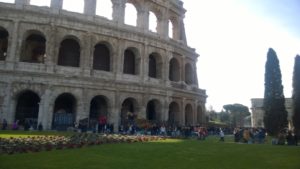 Also known as the” Flavian Amphitheatre” is an oval Amphitheatre in the center of the city Rome, Italy. Build of concrete and sand. It is the largest amphitheater ever built. The Colosseum is situated just east of the Roman Forum. Construction began under the emperor Vespasian in AD 72, and was completed in AD 80 under his successor and heir Titus. The Colosseum could hold, it is estimated, between 50,000 and 80,000 spectators,[5][6] having an average audience of some 65,000;[7][8] it was used for gladiatorial contests and public spectacles such as mock sea battles (for only a short time as the hypogeum was soon filled in with mechanisms to support the other activities), animal hunts, executions, re-enactments of famous battles, and dramas based on Classical mythology.
Also known as the” Flavian Amphitheatre” is an oval Amphitheatre in the center of the city Rome, Italy. Build of concrete and sand. It is the largest amphitheater ever built. The Colosseum is situated just east of the Roman Forum. Construction began under the emperor Vespasian in AD 72, and was completed in AD 80 under his successor and heir Titus. The Colosseum could hold, it is estimated, between 50,000 and 80,000 spectators,[5][6] having an average audience of some 65,000;[7][8] it was used for gladiatorial contests and public spectacles such as mock sea battles (for only a short time as the hypogeum was soon filled in with mechanisms to support the other activities), animal hunts, executions, re-enactments of famous battles, and dramas based on Classical mythology.
- Pantheon (3,75 million tourist a year)
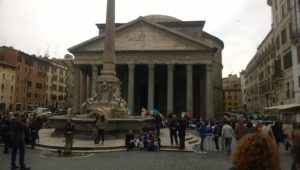 The Pantheon from Greek meaning “temple” of every god” , is a build in Rome , Italy on the site of an earlier building commissioned by Marcus Agrippa during the reign of Augustus (27 BC – 14 AD). It is one of the best-preserved of all Ancient Roman buildings, in large part because it has been in continuous use throughout its history, and since the 7th century, the Pantheon has been used as a church dedicated to “St. Mary and the Martyrs” (Latin: Santa Maria ad Martyres) but informally known as “Santa Maria Rotonda”.[5] The square in front of the Pantheon is called Piazza della Rotonda. The Pantheon is a state property, ruled by Italy’s Ministry of Cultural Heritage and Activities and Tourism through the Polo Museale del Lazio; in 2013 it was visited by over 6 million people.
The Pantheon from Greek meaning “temple” of every god” , is a build in Rome , Italy on the site of an earlier building commissioned by Marcus Agrippa during the reign of Augustus (27 BC – 14 AD). It is one of the best-preserved of all Ancient Roman buildings, in large part because it has been in continuous use throughout its history, and since the 7th century, the Pantheon has been used as a church dedicated to “St. Mary and the Martyrs” (Latin: Santa Maria ad Martyres) but informally known as “Santa Maria Rotonda”.[5] The square in front of the Pantheon is called Piazza della Rotonda. The Pantheon is a state property, ruled by Italy’s Ministry of Cultural Heritage and Activities and Tourism through the Polo Museale del Lazio; in 2013 it was visited by over 6 million people.
Two kings of Italy are buried in the Pantheon: Vittorio Emanuele II and Umberto I, as well as Umberto’s Queen, Margherita.
The Pantheon is in use as a Catholic church. Masses are celebrated there on Sundays and holy days of obligation. Weddings are also held there from time to time.
- Trevi Fountain (3,5 million tourist a year)
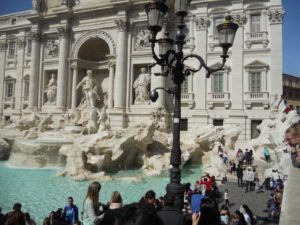 The Trevi Fountain (Italian: Fontana di Trevi) is a fountain in the Trevi district in Rome, Italy, designed by Italian architect Nicola Salvi and completed by Pietro Bracci. Standing 26.3 metres (86 ft) high and 49.15 metres (161.3 ft) wide,[1] it is the largest Baroque fountain in the city and one of the most famous fountains in the world. The fountain has appeared in several notable films, including Federico Fellini’s La Dolce Vita.
The Trevi Fountain (Italian: Fontana di Trevi) is a fountain in the Trevi district in Rome, Italy, designed by Italian architect Nicola Salvi and completed by Pietro Bracci. Standing 26.3 metres (86 ft) high and 49.15 metres (161.3 ft) wide,[1] it is the largest Baroque fountain in the city and one of the most famous fountains in the world. The fountain has appeared in several notable films, including Federico Fellini’s La Dolce Vita.
Legends
Legend holds that in 19 BC thirsty Roman soldiers were guided by a young girl to a source of pure water thirteen kilometres (8.1 miles) from the city of Rome. The discovery of the source led Augustus to commission the construction of a twenty-two-kilometre (14-mile) aqueduct leading into the city, which was named Aqua Virgo, or Virgin Waters, in honour of the legendary young girl. The aqueduct served the hot Baths of Agrippa, and Rome, for over four hundred years.
- Sistine Chapel ( 3 million tourist a year)
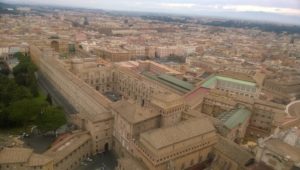
Sistine Chapel from the external( on the corner right of the picture)
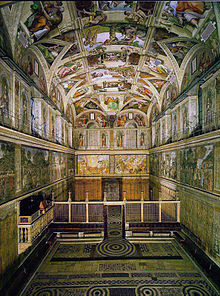
View of the interior of the Sistine Chapel.
The Sistine Chapel (/ˌsɪstiːn ˈtʃæpəl/; Latin: Sacellum Sixtinum; Italian: Cappella Sistina [kapˈpɛlla siˈstiːna]) is a chapel in the Apostolic Palace, the official residence of the Pope, in Vatican City. Originally known as the Cappella Magna, the chapel takes its name from Pope Sixtus IV, who restored it between 1477 and 1480. Since that time, the chapel has served as a place of both religious and functionary papal activity. Today it is the site of the Papal conclave, the process by which a new pope is selected. The fame of the Sistine Chapel lies mainly in the frescos that decorate the interior, and most particularly the Sistine Chapel ceiling and The Last Judgment by Michelangelo.
- The Roman Forum (2,5 million tourists a year)
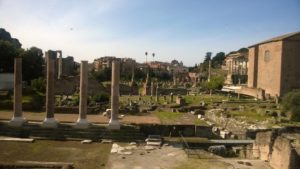 The Roman Forum (Latin: Forum Romanum, Italian: Foro Romano) is a rectangular forum (plaza) surrounded by the ruins of several important ancient government buildings at the center of the city of Rome. Citizens of the ancient city referred to this space, originally a marketplace, as the Forum Magnum, or simply the Forum.
The Roman Forum (Latin: Forum Romanum, Italian: Foro Romano) is a rectangular forum (plaza) surrounded by the ruins of several important ancient government buildings at the center of the city of Rome. Citizens of the ancient city referred to this space, originally a marketplace, as the Forum Magnum, or simply the Forum.
It was for centuries the center of Roman public life: the site of triumphal processions and elections; the venue for public speeches, criminal trials, and gladiatorial matches; and the nucleus of commercial affairs. Here statues and monuments commemorated the city’s great men. The teeming heart of ancient Rome, it has been called the most celebrated meeting place in the world, and in all history.[1] Located in the small valley between the Palatine and Capitoline Hills, the Forum today is a sprawling ruin of architectural fragments and intermittent archaeological excavations attracting 4.5 million sightseers yearly
These are the 5 most visited places in Rome but…there are a lot of other beautiful places that we will explore in the next articles…

